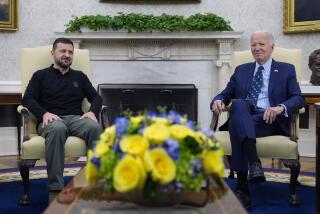Sept. 11 Proved to Be Turning Point for the Predator
- Share via
In a recent test that demonstrated a key advance in drone aircraft, a remotely controlled Predator was able deploy a smaller unmanned aircraft that carried sensors designed to detect chemical weapons.
The Predator was flying at 10,000 feet when it released the second plane. The smaller aircraft was able to fly for 25 minutes and take air samples before returning to its home base--along with its mother ship--at Edwards Air Force Base.
The successful test buoyed prospects for the use of the unmanned aerial vehicles in hostile countries such as Iraq where chemical weapons are considered a likely threat. Both UAVs were controlled by pilots using video monitors in a trailer miles away.
The test also highlighted the utility of the Predator, which has grabbed the attention of Pentagon strategists and reversed years of criticism and indifference to development of pilotless aircraft.
It was exactly a year ago--just days before the Sept. 11 terrorist attacks--that the Predator’s developer stood at a desert airfield watching one of his newest remotely controlled aircraft gently gliding above as he wondered about the prospects for unmanned spy planes.
Officials from NASA and federal firefighting agencies were there as well. The firefighters saw the possibility of using the long-endurance aircraft to fly over wilderness areas in search of wildfires.
But the Predator’s biggest potential customer was nowhere in sight.
For nearly a decade, Thomas P. Cassidy had been pushing the Pentagon to use more remotely controlled planes.
But critics harped on the dismal crash record of past UAVs and fighter pilots snarled at the possibility of robotic planes taking over their jobs.
Cassidy’s firm, General Atomics Aeronautical Systems Inc. of San Diego, had perfected a bigger and more powerful drone, but the Pentagon seemed slow to respond.
That all changed after Sept. 11.
The Predator quickly became a common feature in news reports as it hovered over Afghanistan and provided live video of Taliban and Al Qaeda forces to intelligence personnel, some as far away as Florida.
And it made aviation history when a Predator, jury-rigged with Hellfire antitank missiles, attacked a Taliban convoy.
It was the first time a UAV had tracked, identified and then fired on a target. It even hung around to assess the damage.
The Pentagon hopes that one day the Predator’s recent feat of launching a smaller unmanned plane will become a common battlefield occurrence.
Because the mini-aircraft is expendable, it can be flown over hostile regions or through areas where hazardous conditions such as deadly chemical weapons are suspected.
Moreover, the Predator can hover for more than 24 hours in a particular area and launch the mini-planes at a moment’s notice.
With an eye toward using the technology if a conflict occurs in Iraq, the military is pushing development of a miniature UAV with sensors that can collect air samples, analyze them and relay the findings to troops on the ground.
In addition to its unusual feats, Predator’s near-celebrity status among aviation buffs has grown thanks in part to President Bush, who cited the aircraft as one of the more important U.S. weapons used in Afghanistan and a key example of the military’s transformation. Bush became a fan of the aircraft after watching a video of a military operation that was transmitted live from Afghanistan to the White House.
“Sept. 11 had a very dramatic impact” on increasing interest in the plane, Cassidy said. “It got an awful lot of visibility both with Congress and the Pentagon. All of a sudden we were bombarded with how many can we make a month and how quickly we can increase [manufacturing] capacity.”
Within months, the production rate doubled and hundreds of new employees had to be hired. General Atomics Aeronautical Systems’ factory quickly ran out of space, prompting it to begin looking for more.
Cassidy no longer needed to fly to Washington to pitch the Predator to the Pentagon brass. They were coming to him.
“It’s been hectic,” Cassidy said, noting that the Defense Department has been asking the company to step up development of new uses for their UAV. For instance, the new and larger Predator B version is being outfitted to carry two Hellfire missiles and has been renamed Hunter-Killer.
“A lot of it now is quick reaction work,” Cassidy said.
Last month, Pentagon weapon developers tested a new antitank weapon that could be launched by a Predator. Unlike the Hellfire, the new weapon uses acoustic and infrared sensors to detect, follow and then destroy moving tanks.
The worldwide attention to pilotless planes represents a vindication for Cassidy, a former Navy admiral, and six engineers who formed General Atomics Aeronautical Systems in 1992 and toiled for nearly a decade pushing a technology that to many critics seemed more Buck Rogers than reality.
“Before the war, the Predator had skeptics, because it did not fit the old ways,” Bush said a few months into Operation Enduring Freedom in Afghanistan. “Now, it is clear the military does not have enough unmanned vehicles.”
To some, having a tragic event improve their fortunes may seem bittersweet, but Cassidy said he is proud that his UAVs are being used to fight terrorism.
“People were asking, ‘What are we going to do about Sept. 11?’ ” Cassidy said. “These airplanes are helping us do something about it.”
More to Read
Inside the business of entertainment
The Wide Shot brings you news, analysis and insights on everything from streaming wars to production — and what it all means for the future.
You may occasionally receive promotional content from the Los Angeles Times.










